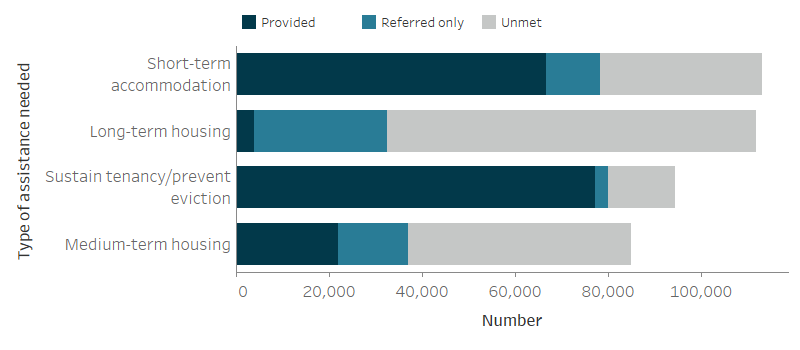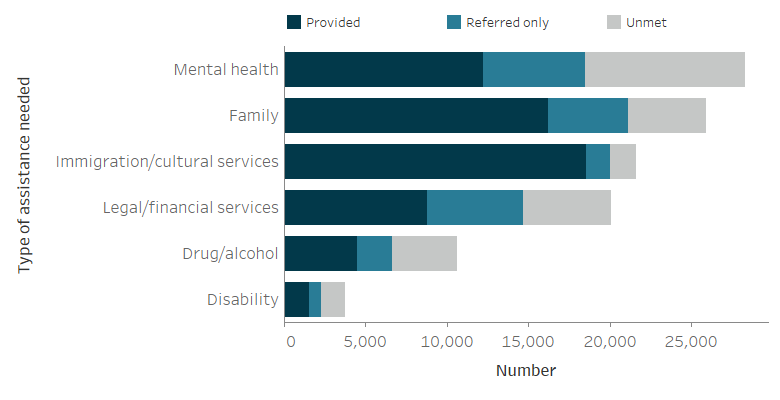Unmet demand for specialist homelessness services
Specialist homelessness services (SHS) in Australia supported, on average, an estimated 66,100 people each day in 2019–20. However, there were also people who approached agencies who were unable to be offered any assistance or who did not receive all the services that they required.
Unmet demand, as reported here, consists of both unassisted requests for service and unmet client needs. It only measures unmet demand for people who approach SHS agencies and is therefore not a measure of the population level unmet demand for support. Results from the 2014 General Social Survey suggest that 67% of those who had experienced homelessness in the ten years prior did not approach an organisation for support during their latest homelessness episode, possibly because most stayed with friends or relatives during periods of homelessness (ABS 2015).
For those that do approach an SHS agency, there may be a range of reasons an agency cannot provide assistance. For example, the person may be seeking a specialised service not offered by that particular agency, the agency may not have the capacity to provide assistance at that time or the person may not be in the target group for the agency. An Australian Council of Social Service survey found that, in 2019, 76% of staff in housing and homelessness services reported an increase in the number of clients they were unable to support and 36% reported rarely or never being able to meet demand (ACOSS 2019).
1. Unassisted requests for services
Identifying unassisted requests for services in the Specialist Homelessness Services Collection (SHSC)
Unassisted requests for services are instances where a person requests assistance from a SHS agency and receives no assistance at the time of request. The SHSC captures limited information about unassisted requests for services, as it is not always appropriate for an agency to collect the same detailed information as they would if the person became a client.
Importantly, for some central intake models, the role of intake agencies is to identify and link clients to an agency well suited to the individual client's needs. This may decrease the number of unassisted requests for services for jurisdictions operating such central intake models.
See Technical information for more information on measuring unassisted requests in the SHSC.
Key findings
- In 2019–20, on average, there were 260 unassisted requests per day; a total of 95,300 unassisted requests for 2019–20, which was 3,000 more than in 2018–19 (92,300).
- Three in 5 (60%) unassisted requests involved short-term or emergency accommodation and over 1 in 4 (26%) unassisted requests involved other housing or accommodation.
- Most commonly, agencies were unable to offer requests for accommodation because there was no accommodation available at the time.
- The majority of unassisted requests were for females (67%).
Unassisted requests for services 2019–20
Across Australia, there were around 95,300 unassisted requests in 2019–20.
- On average, there were 260 unassisted requests per day (Supplementary table UNMET.1).
- Two in 3 (67%) daily unassisted requests were made by females and 33% by males (Supplementary table UNMET.2). Among females, nearly than 1 in 4 (24%) unassisted requests were from females aged 25–34 whereas for males the most common age group was boys aged 0–9 (25% males).
- Nearly 9 in 10 (89%) unassisted requests from single adults with children were from females. (Supplementary table UNMET.7).
Unassisted requests for services, trends over time
Some key trends in unassisted requests since 2015–16 include:
- The number of unassisted requests has varied over time (Table UNASSISTED.1). The increase in unassisted requests in 2019–20 was primarily due to increases in Victoria and Tasmania. For further details, see the data quality information and Technical information.
- The proportion of unassisted requests from persons living alone has decreased from 63% in 2015–16 to 57% in 2019–20 while the proportion of unassisted requests from single parents has increased from 33% in 2015–16 to 35% in 2019–20.
|
|
2015–16 |
2016–17 |
2017–18 |
2018–19 |
2019–20 |
|---|---|---|---|---|---|
|
Number |
100,302 |
95,392 |
86,103 |
92,292 |
95,252 |
|
Sex (per cent) |
|||||
|
Female |
64 |
66 |
66 |
65 |
65 |
|
Male |
36 |
34 |
34 |
35 |
34 |
|
Living arrangement (per cent) |
|||||
|
Lone person |
63 |
60 |
58 |
56 |
57 |
|
Single with child(ren) |
33 |
35 |
37 |
38 |
35 |
|
Couple with child(ren) |
0 |
0 |
0 |
0 |
0 |
|
Couple without children |
2 |
2 |
2 |
2 |
2 |
|
Other family group |
2 |
3 |
3 |
4 |
5 |
|
|
|||||
|
Average number of times a person approached an agency |
1.5 |
1.5 |
1.5 |
1.7 |
1.7 |
|
Unassisted people who become clients (per cent) |
47 |
46 |
47 |
45 |
48 |
Notes:
- Data for 2015–16 to 2016–17 have been adjusted for non-response. Due to improvements in the rates of agency participation and SLK validity, data from 2017–18 are not weighted. The removal of weighting does not constitute a break in time series and weighted data from 2015–16 to 2016–17 are comparable with unweighted data for 2017–18 onwards. For further information, please refer to the Technical Notes.
- The proportion of valid SLKs used to derive the average number of times a person approached an agency and the unassisted people who became clients is relatively low, and therefore both are likely to be an underestimate.
Source: Specialist Homelessness Services Collection 2015–16 to 2019–20.
Analysis of how often a person requested assistance and how many later became SHS clients can only be examined and understood where the statistical linkage key (SLK) was complete and valid (around 52% of all unassisted requests). Of the valid data, in 2019–20 on average each unassisted person approached an agency 1.7 times (Table UNASSISTED.1).
In 2019–20, 48% of people with a valid SLK later went on to become clients and received services during the year, higher than 2018–19 (45%). The future service use experience for the remaining 52% were unknown; they may have received assistance from a non-SHS service, used their own support networks or continued to experience unstable housing or homelessness. Alternatively, these people may go on to become clients in future years.
Services requested
In 2019–20:
- Three in 5 (60%) daily unassisted requests involved short-term or emergency accommodation (Supplementary table UNMET.4).
- Females were more likely than males to have unassisted requests for short-term or emergency accommodation—on average there were almost 100 unassisted requests from females for short-term or emergency accommodation compared with 46 for males.
- Over 1 in 4 (26%) of daily unassisted requests involved housing or accommodation other than short-term or emergency accommodation, with more unassisted requests from females than males (39 and 23 respectively).
- Unassisted requests most commonly came from people presenting alone (167 instances) or single people with children (58 instances) (Supplementary table UNMET.5).
- Most commonly, agencies reported that they could not meet requests for any accommodation because there was no accommodation available at the time of the request (Supplementary table UNMET.6).
2. Client's unmet need for services
Clients receiving support from SHS agencies often need a wide range of services. Some needs arise more than once in a support period and this makes it difficult to assess the extent to which the need has been met from the available data.
Reporting unmet need for services in the Specialist Homelessness Services Collection (SHSC)
Unmet need is recorded when an SHS client has some, but not all, their identified needs for services met. Agencies can also refer clients to another service for assistance.
Key findings
- Almost 170,900 SHS clients (59%) identified a need for accommodation services in 2019–20 and this service was provided to more than half of these clients (nearly 86,400 clients or 51%).
- The ability of agencies to provide certain specialist services was similar to the previous year. For example, in 2019–20, around 1 in 3 (35%) mental health service requests were neither provided nor referred, similar to that for 2018–19 (34%).
Unmet need for accommodation and housing assistance services
Just over half (59%) of all clients needed at least one type of accommodation service (Figure UNMET NEED.1 and Supplementary table CLIENTS.23):
- Nearly 2 in 5 clients (39% or 113,100 clients) needed short-term or emergency accommodation; 6 in 10 (59% or 66,700) of those requesting this service were provided with assistance.
- Almost 2 in 5 clients (39% or 111,900 clients) identified a need for long-term housing; about 4% (4,000 clients) of these clients were provided with this service.
- The number of clients requesting either short-term or emergency accommodation or long-term housing were similarly large; however, the difference in the proportion of clients receiving these types of accommodation highlights the substantial unmet need for long-term housing encountered by SHS clients (71% or 79,300 clients with unmet need for long-term housing).
Figure UNMET NEED.1: Clients with unmet needs for accommodation and housing assistance services, 2019–20

Notes
- Short-term accommodation includes temporary and emergency accommodation; medium-term housing includes transitional housing; and sustain tenancy/prevent eviction includes assistance to sustain tenancy or prevent tenancy failure or eviction.
- 'Unmet' indicates a service was neither provided nor referred.
Source: Specialist Homelessness Services Collection 2019–20, Supplementary table CLIENTS.23.
Unmet need for general and specialised services
Agencies were able to meet the general needs of most clients. For example, of the over 224,700 clients who needed advice/information, 98% were provided assistance, and of the more than 159,700 clients requesting advocacy/liaison, 96% were provided with assistance (Supplementary table CLIENTS.23).
Other types of client needs were less commonly met. For example, among those SHS clients who required professional legal services (3% or 9,000 clients), the level of unmet need was substantial, around 27% at the end of support. This may be because of the specialist skills required to provide legal services and the limited availability of these skills within the SHS agencies and other referral services offered to clients.
The level of unmet need for broad groups of specialised services can be determined (Figure UNMET NEED.2)
- Mental health services, including psychological, psychiatric and mental health services, were one of the most common specialised services needed by clients; however, these needs were frequently unmet with 1 in 3 clients (35%) neither provided nor referred these services.
- Nearly 4 in 10 clients identifying a need for disability services (38%) or drug and alcohol services (37%) did not have their needs met.
- Immigration and cultural services, needed by 7% of SHS clients (about 21,600 people), were provided for most requiring them (86%).
Figure UNMENT NEED.2: Clients with unmet needs for specialised services (grouped), 2019–20

Notes
- Excludes 'Accommodation provision', 'Assistance to sustain housing tenure', 'Other specialist services' and 'General services'.
- 'Unmet' indicates a service was neither provided nor referred.
Source: Specialist Homelessness Services Collection 2019–20, Supplementary table CLIENTS.23.
References
ABS (Australian Bureau of Statistics) 2015. General Social Survey: Summary Results, Australia, 2014. ABS Cat. no. 4159.0. Canberra: ABS.
ACOSS (Australian Council of Social Service) 2019. Demand for Community Services Snapshot December 2019. Sydney: ACOSS.


